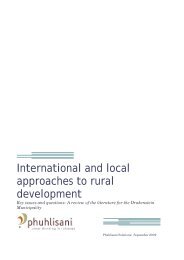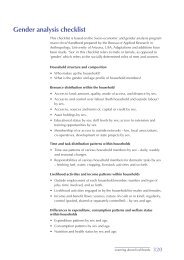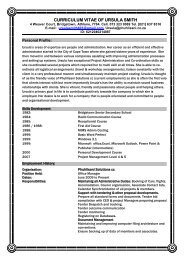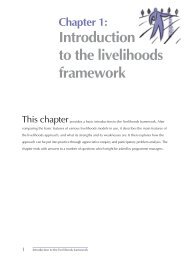Chapter 6.pdf - Phuhlisani
Chapter 6.pdf - Phuhlisani
Chapter 6.pdf - Phuhlisani
You also want an ePaper? Increase the reach of your titles
YUMPU automatically turns print PDFs into web optimized ePapers that Google loves.
<strong>Chapter</strong> 6Settlement and Implementation Support (SIS) Strategy for Land and Agrarian Reform in South Africa <strong>Chapter</strong> 6215
<strong>Chapter</strong> 6Settlement and Implementation Support (SIS) Strategy for Land and Agrarian Reform in South Africa <strong>Chapter</strong> 6A framework for securing effectivesettlement and implementationsupport216
Contents1 The chapter at a glance 2182 Background 2183 The function of the SIS Strategy 2184 Towards a strategy for sustainable landreform 2194.1 The SIS strategy development approach 2195 The strategy development process 2206 Strategy fundamentals: An area-basedapproach 2207 An overview of the SIS framework 2217.1 A shared mission… 2227.2 …rooted in clear legislative mandates 2227.3 Locating the mission within a SISframework 2237.4 Elements of the framework identifyingthe key elements of SIS 2237.4.1 Area-based support 2237.4.2 Creating an enabling environmentfor effective SIS delivery 2257.5 An integrated framework 2258 Conclusion 2259 <strong>Chapter</strong> references 226Settlement and Implementation Support (SIS) Strategy for Land and Agrarian Reform in South Africa <strong>Chapter</strong> 6217
Settlement and Implementation Support (SIS) Strategy for Land and Agrarian Reform in South Africa <strong>Chapter</strong> 61 The chapter ata glanceThis chapter outlines the overarching conceptualframework which the SDC has developed to integrateeach area of proposed strategic intervention. Whileframeworks are composed of discrete elements, thechapter emphasises the connections and integrationbetween them.The framework sets out to provide a counterpoint tothe current silo-based and fragmented approach toplanning and PSS for land reform.2 BackgroundThus far the base document has:• assessed the challenges associated with thedevelopment of an evidence-based strategy;• provided an overview of the evolution of theland reform programme and the changingdevelopment environment in which it operates;• provided an analytic review of the evidence toidentify key support requirements of Restitution,LRAD and Commonage projects and the keyissues currently impacting on the provision ofeffective SIS before and after the transfer of land;and• extracted key learnings from a comparativereview of the international experience from fivecountries.The evidence highlights that there are four domainswhich must be addressed if effective settlement andimplementation support is to be provided. These havebeen organised into a conceptual framework whichcombines four interlocking quadrants.Quadrant 1: Functional alignment and spatialintegration focuses on the institutional arrangementsrequired to deliver settlement and implementationsupport and align different government departments,municipalities and other actors in the planning andpost-transfer support processes within an area-basedapproach.Quadrant 2: Social, institutional and capacitydevelopment brings together the strategies requiredto ensure that membership and rights are clearlydefined and that robust land-holding and landrights management institutions are put in place andsupported to fulfil the key constitutional and legalmandates which underpin the land reform programme.This quadrant also sets out what must be doneto promote social development, minimise the riskof HIV/Aids and mitigate its impacts, and enablethe acquisition of key skills and enhancement ofcollaborative learning at all levels.Quadrant 3: Integrated natural resourcemanagement and sustainable human settlementsexamines how to develop an integrated approach toland use planning and the management of naturalresources. It also focuses on what must be doneto enable the planning and servicing of sustainablehuman settlements.Quadrant 4: Livelihoods, enterprise developmentand business support explores improved strategiesto better ensure that land reform projects start byaddressing the needs of the members, enablinghousehold livelihood security and improving enterpriseviability and access to finance and markets.Quadrants 2–4 also address the need for recoverystrategies for existing projects where these arerequired.Linked to the four quadrants are the key enablers suchas improved communications and information systemsenabling data capture and analysis, decision support,M&E and reporting. Specialist chapters deal with theseaspects together with an in-depth assessment of theinstitutional options to effect the changes that areavailable to the DLA.3 The function of theSIS StrategyThe SIS Strategy sets out to provide perspectiveand direction for the DLA and its partners in what iscommonly referred to as post-settlement support.The strategy provides the bridge between overarchingmandates (fulfilling the requirements of theConstitution, law and policy) on the one hand, and218
Figure 6.1: Elements of the evidence-based SIS strategy development processLand reformSecuring rights, livelihoods and developmentWhere do wewant to be?SharedperspectiveSIS StrategyIMPLEMENTAT IONQuick wins20142012201020082006StrategyHow we get thereWhere arewe nowEvidence-based analysis andstrategy developmentconcrete actions or programmes to give effect to theseon the other.It provides a framework for delivering sustainableRestitution, LRAD and Commonage projects whichmeet constitutional obligations, ensure secure andequitable access to land and deliver meaningful andsustainable economic and livelihood benefits.4 Towards a strategyfor sustainable landreformThe Strategy has been developed based on an analysisof the evidence and experiences derived from thelocal and international experience and the complexand dynamic environment in which the land reformprogramme operates. This has involved:• learning from the experience of land reformimplementation to date (where we have comefrom);Where have we come from?• reviewing the status quo (where we are now);• determining critical success factors andindicators of an effective land reform programme(where we want to be); and• mapping out the practical steps to move forwardfrom the current situation to where we want theland reform programme to be in the year 2014(how we get there).4.1 The SIS strategydevelopment approachThe strategy has been developed out of an evidencebasedapproach that draws on a variety of sourcesand multiple processes.The evidence is drawn from:• a review of the literature, both local andinternational, focusing on the experienceof implementing Restitution, LRAD andCommonage, and land reform more broadly;Settlement and Implementation Support (SIS) Strategy for Land and Agrarian Reform in South Africa <strong>Chapter</strong> 6219
Settlement and Implementation Support (SIS) Strategy for Land and Agrarian Reform in South Africa <strong>Chapter</strong> 6• commissioned diagnostic case and thematicstudies that cover different elements of theland reform programme – Restitution claimsin different contexts, LRAD and Commonageprojects;• a learning programme that has involved landreform practitioners from different departmentsand provincial contexts, and in-depth reviewsof selected Restitution, LRAD and Commonageprojects to identify key lessons and implicationsfor national strategy development;• a programme of technical support to selectedprojects which is designed to provide evidenceof which practical interventions and institutionalarrangements are needed for effective delivery ofSIS services;• a series of consultative forums that bringtogether key provincial actors responsible for thedelivery of SIS services, enabling different roleplayersto think strategically and critically aboutappropriate support; and• a review of the policy and legislative frameworkthat frames land reform implementation withrespect to securing effective intergovernmentalrelations, securing rights and equitable accessof people acquiring land through the land reformprogramme, facilitating integrated naturalresource management, and facilitating thesustainable servicing of new settlements.5 The strategydevelopment process• Phase 1: Development perspective phase: Thisphase involved a range of activities includingthe compilation of the SDC Status Quo Reporton Restitution, a linked research and learningprogramme, consideration of research work,reports and manuals, work on the ground withland reform practitioners, and the holding ofconsultative forums to develop a commonapproach and a shared conceptual framework forproviding SIS support to Restitution, LRAD andCommonage projects.• Phase 2: The strategy development phase:Based on the analysis of a broad range of issuesin Phase 1, this phase entailed the developmentof detailed strategy proposals based on anarea-based approach to land reform and anexploration of possible institutional models for thedelivery of SIS services. Following presentations,adjustments and approval of the SIS Strategy, anongoing communication strategy will be initiated.Priority first steps and ‘quick wins’ will beidentified for immediate action in each strategicarea.• Phase 3: Area-based planning and phased rollout:This phase sees the identification of startupdistricts in each province, the negotiation ofintergovernmental institutional arrangements,the formation of dedicated SIS teams, auditsof agreed start-up areas, development of areabasedplans and co-ordinated provision of SISservices across the four strategic quadrantsidentified above. This will be underpinned by alearning process approach which contributesto reflexive practice, ensures documentation oflessons learned, and ensures the continuousassessment and adjustment of the roll-outprocess. In parallel with this, new SIS institutionalarrangements will be finalised in line withinstitutional choices made in Phase 2. Once theinstitutions are in place, the DLA and its partnerswill be in a position to mainstream the SISStrategy.Proposals for policy and law reform are dealt withthroughout. However, our approach to strategyformulation is to show how implementation is possiblewithin existing legal frameworks.6 Strategyfundamentals: An areabasedapproachThe SIS Strategy is premised on a rights-basedapproach to livelihoods as formulated in the contractTerms of Reference (described in <strong>Chapter</strong> 2). It restson an integrated, area-based approach to land reformplanning and implementation. The Strategy envisagesa seamless planning and implementation processin terms of which planning and implementation arenot artificially divided into two distinct but sequentialphases (Clay & Shaffer 1984). The approach220
Figure 6.2: The strategy development and roll-out processDevelopmentperspective phaseStrategydevelopment phaseArea-based planningand phased roll-outStatus Quo ReportAnalysis through diagnosticand thematic researchProject supportLearning programmePolicy and legislative reviewArea-based approachSpatial and functionalintegrationInstitutional and capacitydevelopmentIntegrated NRM andsustainable settlementsLivelihoods, enterprise andtechnical supportSelection of one district perprovinceEstablishment of settlementsupport teamsArea-based plan and integrationinto IDPProvision of support servicesand linked learning programmeReview and adjustmentSettlement andimplementation support(SIS) frameworkrecognises that key choices are made in the planningphase which have major implications for the allocationof rights and which directly affect the nature of the SISservices required.This seeks to overcome the constraints of the currentapproach that involves land reform mandates beingcompartmentalised and independently delivered on aproject-by-project basis by CRLR offices, PLROs andother departments, spheres and institutions. As theevidence in <strong>Chapter</strong> 4 shows, the current approach hasresulted in institutionally and spatially fragmented landreform delivery which is poorly supported. By and large,this has not delivered sustainable land reform projects.Consistent with the Area-Based Planning process beingindependently developed within DLA, the approachsets out to ensure that land reform is firmly embeddedwithin municipal IDPs and spatial developmentframeworks, and supported by governmentdepartments in line with their respective legislativemandates. The strategy seeks to make maximum useof the obligations contained in law and policy to secureco-ordinated and effective support from all organs ofstate within each sphere of government (as requiredInstitutional delivery optionsCommunicationQuick winsNew SIS institutionalarrangementsStrategy review andadjustmentStrategy mainstreamingby Section 41(1) of the Constitution). The Strategyalso highlights the potential roles of public-privatepartnerships, the private sector and civil society.Consistent with the international experience of landreform documented in <strong>Chapter</strong> 5, the SIS Strategygives particular emphasis to the importance ofstimulating self-organisation, agency, peer learningand mutual support among the people who acquirerights and access to land through the land andagrarian reform programme. This is a key elementof sustainability. It sets out to create an enablingenvironment that will strengthen this self-organisationat area, district, provincial and national scales.7 An overview of theSIS frameworkThe framework overview is simply a device to helpcontextualise and locate the different elements of theSIS Strategy. It identifies four key strategic thrusts andhighlights principal components of an enabling legal,institutional, planning and development environmentSettlement and Implementation Support (SIS) Strategy for Land and Agrarian Reform in South Africa <strong>Chapter</strong> 6221
which give legal force and practical effect to thedifferent strategic interventions.7.1 A shared mission…A simple mission statement guides the SIS Strategy:of land reform are achieved. This means that thesuccess of the programme is everybody’s business.The SIS Strategy identifies the legislative mandateswhich secure the contribution of the relevant linedepartments and municipalities to the provision of SISservices.Settlement and Implementation Support (SIS) Strategy for Land and Agrarian Reform in South Africa <strong>Chapter</strong> 6The delivery of effective settlement and implementationsupport which contributes to successful land andagrarian reform to reduce poverty, enhances livelihoodsecurity, boosts economic growth, enables security oftenure and sustainable land use.This visualises the contribution that effectivelysupported Restitution, LRAD and Commonage projectswill make to the attainment of the high-order goals ofland reform.Effective SIS contributes to successful land reformand to making a significant contribution to povertyreduction, livelihood security, economic growth,security of tenure and sustainable land use throughrestitution, more equitable distribution of land andrapid land release.7.2 …rooted in clear legislativemandatesThe mission is anchored in the Constitution, particularlySections 25(4)–(8), which deal directly with landreform-related issues. In addition, Section 25(8) statesthat:No provision of this section may impede the statefrom taking legislative and other measures to achieveland, water and related reform, in order to redressthe results of past racial discrimination, provided thatany departure from the provisions of this section is inaccordance with the provisions of section 36 (1).Also of relevance is Section 24(b)(iii) which guaranteesthe right to a healthy environment and requiresenvironmental protection to ensure ecologicallysustainable development and use of natural resourceswhile promoting justifiable economic and socialdevelopment.The SIS Strategy is based on the assumption thatland reform is a national development priority. TheState and indeed the South African people areconstitutionally obliged to ensure that the objectivesApart from the DLA undertaking its core businessin terms of an interlocking suite of legislation, weemphasise in particular the means to give effectto the principles of co-operative governance andintergovernmental relations set out in Section 41(1)of the Constitution. This is further elaborated throughthe Intergovernmental Relations Framework Act.Section 35 of this Act makes provision for enforceableimplementation protocols between co-operatingspheres of government and provides a frameworkfor joint programmes of government. The LocalGovernment: Municipal Systems Act (widely knownas the Municipal Systems Act) locates government’sresponsibilities to align all development initiativeswithin the framework of municipal IDPs.The mission also serves to locate land reform withinthe framework of the Accelerated and Shared GrowthInitiative for South Africa (AsgiSA), which emphasisesthat:Without interventions directly addressed at reducingSouth Africa’s historical inequalities, growth isunsustainable. Conversely, successful measures toreduce the inequalities will add impetus to growth.Government has already initiated interventions toaddress deep-seated inequalities and target themarginalised poor, to bridge the gap with the SecondEconomy, and ultimately to eliminate the SecondEconomy (Presidency 2006).The SIS Strategy has been conceptualised as anintervention by the DLA and NDA and their partners toreduce poverty and inequality, ensure the sustainabilityof past and future investment in land reform, whileensuring livelihood security and stimulating growth.The SIS approach articulates directly with DLA’s currentmission to provide enhanced land rights to all SouthAfricans, with particular emphasis on black people,that would result in increased income levels and jobopportunities, productive land use and well-plannedhuman settlements.222
7.3 Locating the missionwithin a SIS frameworkThe framework draws on the evidence from theassessment of Restitution, LRAD and Commonageprogrammes to identify the principal factorscontributing to successful and effective projects. Thisframework identifies the key dimensions of effectiveSIS and the main features of an enabling environmentrequired to provide this. It provides the foundation forthe development of the detailed Strategy elaborated insubsequent chapters.For the SIS Strategy to be effective, it must beanchored within the law and guided by sharedobjectives which are simple and clear, which can beaccepted and internalised by all the actors, and whichcan provide a benchmark for M&E.between what needs to be put in place on the groundand the enabling environment, which come together toprovide effective SIS services to land reform projects.7.4.1 Area-based supportAs highlighted above, the approach dovetails with theArea-Based Planning process being independentlydeveloped within DLA. The approach sets out to ensurethat land reform is firmly embedded within municipalIDPs and spatial development frameworks and issupported by government departments in line with theirrespective legislative mandates.Currently the DLA ABP process is focusing through adistrict lens. While this is a useful starting point, SISwill probably need to be planned and delivered onsmaller scales, influenced by particular geographies ofland reform within municipal boundaries.7.4 Elements of the frameworkidentifying the key elements ofSISThe framework identifies the critical elementsthat must be in place to fulfil the mission andconceptualises the relationship between them. Itidentifies the key enabling influences in the externalenvironment which must be harmonised for maximumimpact. The framework makes the connectionsFigure 6.3: The link between strategic mission and functional integrationAgreeing ona mission andframework forSIS to provide theorganising logic......to enable theorganisation andintegration of differentfunctions, actorsand related strategicelementsThe SIS Strategy assumes that areas may be as smallas a ward or as large as a local municipality boundary.Areas are identified and planned within the contextof the municipal IDP. Projects within a designatedarea will be planned holistically and supported by thedelivery of a suite of SIS services. This will be enabledby the formation of dedicated teams within local SISsupport entities which work in partnership with localassociations representing land and agrarian reformprojects to co-ordinate four key areas of responsibilityarranged in four interlocking quadrants:The mission and the strategic frameworkare like the picture on a jigsaw puzzlebox which helps us put the pieces ofthe puzzle together. It enables us toidentify the relationships between theindividual pieces or strategic elementsand to fit them together to make acoherent whole. An agreed SIS framework,combined with a clear delineation ofroles and responsibilities based onthe legal mandates and obligations ofdifferent government departments andmunicipalities, provides a starting point formore effective support.Settlement and Implementation Support (SIS) Strategy for Land and Agrarian Reform in South Africa <strong>Chapter</strong> 6223
Figure 6.4: How the elements of the strategic framework fit togetherResultsArea-based supportActorsSettlement and Implementation Support (SIS) Strategy for Land and Agrarian Reform in South Africa <strong>Chapter</strong> 6Capacity & institutional developmentLand rights management, CPI support,customised trainingDetermination of rights, capablepeople, functional CPIsKey SIS functional areasFunctional & spatial integrationStakeholder mobilisation, service agreements,IDP integrationLand reform sector plan in IDP, jointprogramme agreementsDedicated SIS delivery entitiesat national and area levelsLocal land reform participantassociationsSustainable livelihoods, viable enterprises,finance & market accessGrants, loans, extension support, business entity& enterprise development servicesFigure 6.5: How the proposed SIS Branch/Chief Directorate might functionSkills, land & business entitylegislationEnabling policy &legislationSustainable resource management& living environmentsLivelihood, enterprise & technical supportSkills Development Act, CPA Act,Trust Property Control Act...Enabling environmentConstitution, local government& planning legislationIGRFA, Municipal Systems Act, IDP, SDF,ISRDP...SIS Branch/Chief DirectorateSecuring service agreements in linewith legislative mandates & IGRFA,co-ordination, communication,information management, knowledgesharing, management of area-basedSIS delivery entities, monitoring,evaluation and reviewRestitution Act, Act 126, ESTA, LTA,BBBEE Act,CASP...Land reform, agriculture & DTIpolicy & legislationWater rights, biodiversity, grazing, fire,settlement planningIntegrated NRM & sustainablesettlementsCommunications, information systems & M&ENWA, NFA, NVFFA, NEMA, CARA...Environmental legislationKey roles224
1. Functional alignment and spatial integration.2. Social, institutional and capacity development.3. Integrated natural resource management andsustainable human settlements.4. Livelihoods, enterprise development and businesssupport.7.4.2 Creating an enabling environmentfor effective SIS deliveryIt is proposed that the process be facilitated byestablishing a new SIS Branch or Chief Directoratewithin DLA which will be responsible for identifying thelegislative mandates that different departments haveto support land reform and for utilising the IGRFA,the Governance and Administration Cluster (2005)guidelines for joint programmes and the Ministryfor Provincial and Local Government (2007) draftguidelines for managing joint programmes, to secureeffective intergovernmental support for land andagrarian reform. The key functions of this entity willinvolve:• Managing the area-based teams operating bymeans of local SIS support entities.• Utilising the provisions of the Municipal SystemsAct and related planning legislation to ensureland and agrarian reform is effectively integratedinto municipal IDPs, and to ensure that aland reform sector plan is prepared at districtmunicipal scale.• Securing support from DWAF, DEAT, NDA,provincial departments responsible forenvironmental affairs and agriculture and otherrelevant departments in terms of their legislativemandates to ensure adequate resourceappraisal, management and monitoring. Thiswould involve the establishment of a nationalfocus team to support Restitution claims onconservation land which involve co-managementof resources.• Co-ordinating and aligning land reform grantsand services, CASP funding and sources ofcommercial and development finance with aview to decentralising funding approval to locallevel where sufficient financial management andsystems of accountability are in place.• Developing and implementing a national land andagrarian reform and rural development capacityand institutional development strategy acrossthree spheres – capacitating land and agrarianreform participants and supporting land-holdingand business entities; developing competent staffwithin the support entity and area-based teams;and ensuring that other key institutional actorscan locate their responsibilities within the overallland and agrarian reform delivery framework.7.5 An integrated frameworkThe elements in Figure 6.6 combine to create anintegrated SIS delivery framework.The framework is guided by the overall vision rooted inlaw and the Constitution, implemented by area-basedsupport teams and partnerships with the support ofnational and provincial SIS entities.It combines key elements to create an overall enablingenvironment to drive area-based land and agrarianreform that results in sustainable projects and therationalisation and co-ordination of essential supportservices.To ensure that all dimensions of the framework areeffectively articulated with one another, SIS entities willrequire a comprehensive information and knowledgesharingenvironment, effective communicationinstruments, and a system for M&E and review toprovide decision support. This will provide essentialmanagement information and enable the developmentof a learning, flexible and adaptive support entity.8 ConclusionThe framework offers a holistic approach to theprovision of settlement and implementation support.In <strong>Chapter</strong>s 7–10, we unpack the strategic approachfor each quadrant. In <strong>Chapter</strong>s 11–13, we examinethe institutional options in more detail, identify keyfeatures of an effective information management andM&E system, and set out the proposed approach tocommunicating the Strategy and keeping all roleplayersup to date and well informed.Settlement and Implementation Support (SIS) Strategy for Land and Agrarian Reform in South Africa <strong>Chapter</strong> 6225
Figure 6.6: Elements of an integrated SIS delivery frameworkConstitution, local government & planning legislationIGRFA, Municipal Systems Act, IDP, SDF...Settlement and Implementation Support (SIS) Strategy for Land and Agrarian Reform in South Africa <strong>Chapter</strong> 69 <strong>Chapter</strong> referencesBroad-Based Black Economic Empowerment Act 53 of2003.Clay, E & Shaffer, B. 1984. Room for manoeuvre: Anexploration of public policy in agricultural and ruraldevelopment. London: Heinemann.Conservation of Agricultural Resources Act 43 of 1983.Extension of Security of Tenure Act 62 of 1997.Governance and Administration Cluster. 2005.Framework for managing joint programmes.December 2005. www.dpsa.gov.za/documents/mos/framework_24_03_200<strong>6.pdf</strong>, accessed 22May 2007.Intergovernmental Relations Framework Act 13 of2005.Less Formal Townships Establishment Act 113 of1991.Skills, land & business entity legislationLocal Government: Municipal Systems Act 32 of 2000,as amended.Skills Development Act, CPAs, trusts, companiesCapacity & institutionaldevelopmentDetermination of rights, capablepeople, functional CPIsSpatial & functional integrationLand reform sector plan in IDP, jointprogramme agreementsMissionThe delivery of effective settlementand implementation supportcontributes to successful land andagrarian reform to reduce poverty,enhance livelihood security, boosteconomic growth, enable securityof tenure and sustainable land use.Sustainable livelihoods, viable enterprises,finance & market accessLivelihood, enterprise & technicalsupportMinistry for Provincial and Local Government. 2007.Draft guidelines for managing joint programmes.Government Notice 492, Government Gazette24846, 26 April 2007.National Environmental Management Act 107 of 1998,as amended.National Forests Act 84 of 1998, as amended.National Veld and Forest Fire Act 101 of 1998, asamended.National Water Act 36 of 1998.Presidency. 2006. Accelerated and Shared GrowthInitiative for South Africa (AsgiSA). www.info.gov.za/asgisa/asgisa.htm, accessed 22 May 2007.Provision of Land and Assistance Act 126 of 1993,as amended (formerly known as the Provision ofCertain Land for Settlement Act 126 of 1993).Restitution of Land Rights Act 22 of 1994, asamended.Sustainable resource management& living environmentsRestitution Act, Act 126, ESTA, LTA, BBBEE Act, CASP...INRM & sustainablesettlementsLand reform, agriculture & DTI policy and legislationNWA, NFA, NVFFA, NEMA, CARA, LEFT EAEnvironmental & township legislationSkills Development Act 97 of 1998, as amended.226







